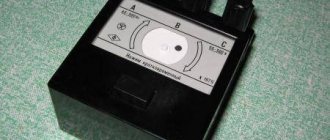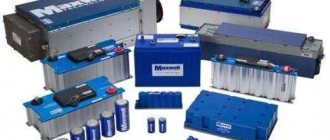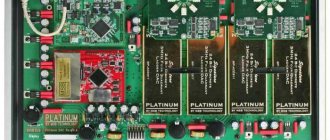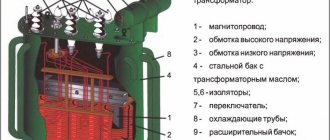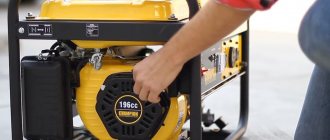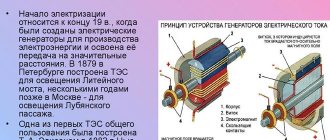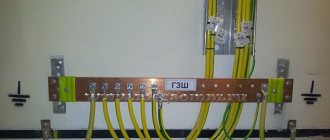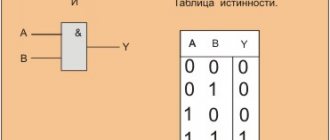What is phase and phase shift
From the name of the device you can guess that the phase is measured. In fact, it is a phase shift. In the electrical power industry, this word denotes two different concepts at once - a physical conductor on which there is potential (voltage), and the state of the level of this potential or current strength at a specific moment in time.
From the school curriculum, everyone remembers the graph of changes in alternating voltage and current in the form of sinusoids. Ideally, they are completely identical. But in practice this is not always done.
When connecting equipment with high inductance (electric motors or high-power transformers) to the network, the rate of current rise lags behind the voltage. This is called a phase shift.
Basic principles of classification of phase meters
As an electrical measuring device, phase meters are classified according to several criteria:
- Based on the design:
- analog (electromechanical, electrodynamic);
- digital (electronic).
- By number of phases:
- single-phase;
- three-phase.
Single-phase instruments are designed to determine the phase angle in single-phase circuits, and 3-phase instruments allow measurements to be made in a full-wire three-phase circuit. Structurally, such devices are not much different, the difference is that in a single-phase device all the moving frames are located relative to each other at an angle of 90 degrees, and in a 3-phase device - at 60 degrees.
Measuring cos φ at industrial frequencies is carried out using electromechanical devices with direct reading, which use a logometer (ferrodynamic, electromagnetic, induction, electrodynamic) as a measuring mechanism. The deviation of the moving part of the ratiometer is determined by the phase shift of the corresponding current and voltage.
For a wide range of frequencies, electronic counting meters of time intervals from the moment of passage of related phase oscillations through 0, and graduated phase shifters in an ensemble with indicators of zero phase difference (for example, phase detectors) are used as a phase meter.
Electronic type phase meters are made in the form of a separate unit. Its front panel displays a microammeter, the scale of which is graduated in degrees, a power supply switch, and input terminals for the measured signals.
All components of the device are mounted on a printed circuit board made of foil fiberglass and secured to the measuring clamps of a microammeter.
The board is connected to the input terminals using a shielded wire, which ensures high noise immunity.
The error of the electromechanical phase meter is 1-3°, electronic - 0.06-0.1°.
Reactive power and cosine phi
This phenomenon is explained by the fact that inductance prevents an increase in current strength, and a decrease, on the contrary, slows it down, and when the voltage is zero, it releases it back into the network.
If you look at the graph of such a process, you can see that the angle between the current and voltage sinusoid changes in proportion to the lag.
The numerical value of the cosine of this angle (from -1 to +1) corresponds to the ratio of reactive power to total power, and is called the power factor or cosine phi. It shows how much of the incoming current is used for its intended purpose.
The main task of the phase meter is to measure this parameter. In a three-phase network, it is possible to determine the relative phase shift under uneven load.
Operating principle of the phase meter
Phase meters operate using the following principle: thanks to an adjustable phase shifter and a sound generator, 2 sinusoidal voltages are generated, shifted by 90°. They are fed to the vertical and horizontal deflection plates of the oscilloscope, generating a circular scan.
In this case, one of the voltages is connected to the input of the quadripole under study. And an electronic relay is connected to the output. The output differentiated pulses of the electronic relay modulate the electron beam of the oscilloscope so that a mark appears on the visible part of the tube screen, the location of which is determined by the phase shift brought by the quadripole. The reference point is established by connecting the input of the electronic relay to the input of the quadripole, and using an optical device, the angle between the reference point and the mark is measured.
You can watch an interesting video about the operation of the phase meter below:
Connection
As a rule, the instructions for using the phase meter describe in detail the connection method. In its absence, it is not very difficult to do it yourself.
It is required to connect the terminals of the device with the corresponding symbols and connectors to the voltage and current circuits (to the phase wire break).
- Technological maps in construction - what is it?
- How to fix a laptop that won't charge
Insulated dielectric screwdrivers up to 1000V - tips on how to choose the best manufacturer
As a last resort, you can always use the Internet and find the necessary description.
Digital phase meters
These devices are manufactured in different ways. For example, phase meters with compensation torque are one of the most accurate devices, although they are configured and controlled manually. They operate differently than the devices we wrote about above.
These devices contain voltages with sinusoids. They are determined by shifting the phases. The voltage passes to an element called a phase rotator. It is controlled by a code coming from the control device.
The shift will be measured in a certain time period until the so-called oscillation phase is reached. Thanks to the detector, you can determine how correctly the phases need to be shifted.
Through the detector, the input signal passes to the device with the help of which control is realized. Thanks to pulse coding, the necessary algorithms are implemented.
When the values balance, the phase meter input codes show the phase shift values. Through this principle, this device can perform its functions.
The discrete count is the main one for the operation of the device. This technique works in several stages. First of all, the phase shift is transformed into signal indicators with a certain duration. After this, the length of the pulses is measured.
Phase meters of this type include in their device:
- A transducer that turns shear into impulse.
- Temporary type selector.
- The part that generates discrete pulses.
- Counters.
- A device through which the device can be controlled.
At the same time, we note that devices of this type have almost no errors in measurements, since the calculation does not occur at once, but over several time intervals.
Criterias of choice
First you need to decide what the device is needed for, where and how it will be used. Will it only be recording the presence and magnitude of reactive power in stationary conditions and in a standard power grid, or will accurate measurements over a wide range be required for calculating device parameters and designing power supply systems.
In the first case, an inexpensive analog phase meter would be a good solution. For the second, one of the digital versions is more suitable.
If you need to take measurements in different places, there are several small, discrete mobile devices on the market.
For a qualified energy specialist, choosing the appropriate device will not be difficult.
For those less knowledgeable, you just need to take into account the above criteria, evaluate the price-quality ratio, the brand awareness of the manufacturer and the reliability of the equipment supplier.
In any case, when choosing a phase meter, you should be guided by expediency and common sense, so as not to overpay for unnecessary functions, a high accuracy class that is not required, or “beautiful” options.
User manual
To understand the use of the phase meter, the main attention is paid to the operating instructions (included with the device). There are a few steps you need to take before you begin.
First, you should make sure that the operating conditions correspond to those recommended by the manufacturer, and the frequency range is in accordance with the metrological characteristics. After this, the circuit itself is assembled.
The phase meter is operated according to the following algorithm:
- First you need to read the instructions that come with the product. The document reveals the nuances and rules for using the device.
- Using the corrector, the arrow is set at the 0 mark.
- Make sure the buttons are not actuated.
- Connect the input probes to the required connectors.
- Press the key that supplies power to the device. Pay attention to the lighting of a special indicator.
- Wait a while for the device to warm up well. This is necessary to achieve maximum measurement accuracy. On average, the exposure time should be about 10-15 minutes.
- Find the input voltage.
- Press the button depending on the choice of external voltage and set the required frequency range.
- Press “>0<” for a pair of channels and “+”.
- Connect the channel probes to the 4-pole input.
- Set the limit switch to position “20”.
- Then move the meter needle to the “zero” position using the regulator.
Photos of phase meters
Did you like the article? Share
1+
Types of phase meters
Like any other device, the phase meter is divided into two main types: electrodynamic and digital. They do not have any distinctive features in the quality of their work, but switches are very popular among professionals in this field, as they clearly show changes in the network.
Professional fuzzometer
There are phase meters that are used only in laboratories. They are often used in electrical installations that require repair. The principle of their operation is no different from each other.
The optimal standard for electrical equipment that requires adjustment is electrodynamic type phase meters. In addition, most often they become part of some universal device that is used in various fields.
The best manufacturers of sockets and switches for your home. TOP most purchased, according to buyers.
The same effect occurs with panel devices, in the production of which the rule of universality is also applied. A large number of such devices are combined into one, which has many functions, measures many indicators, and meets the needs of users.
Electrodynamic
The design of this type of instrument consists of a simple ratiometric device capable of correctly determining phase displacement. The device has two frames that are tightly connected, their angle is 60 degrees. These frames are attached to axles, which are fixed to supporting nodes. This characteristic feature contributes to the absence of mechanical resistance.
Dynamic phase meter
The device has a special mechanism that rotates at an angle, which determines the phase movement parameter. Using a linear scale, a professional in the field can record the value and set the value of the current offset.
The device structure is made of a fixed current coil and two movable current-carrying coils. This pair of coils carries its own currents, which creates an electromagnetic flux in all three coils.
A quick and proven method from experts on how to connect an outlet
When magnetic fluxes come into contact, a pair of torques are generated, the size of which is determined by the distance between the elements of the invention. The volume of rotating moments is determined by the amount of current flowing in the dynamic coils, as well as the amount of current in the stationary coil. In addition, these parameters are dependent on technical characteristics and phase angle offset.
As a result, the moving element of the tool rotates under the influence of torques until they are aligned.
The advantages of this type of phase meters are low price, accuracy of measured indicators, and reliability in use.
The downside is that the indicators are determined by the frequency parameters. In addition, when using this type of measuring device, a large power consumption occurs.
Digital
The production of digital phase meters uses various technologies. Thus, the compensation device contains manual control, but the indicators obtained as a result of measurements have fairly accurate values. This type of phase meter is based on the ionic operating principle.
Digital phase meter kit
When taking measurements, a pair appears that has a sinusoidal appearance. At the initial stage of the process, a phase shifter is supplied through this pair, which is controlled using a special mechanism.
The measurement procedure occurs in a measured state until the phases coincide. During regulation, the phase shift indicator is monitored by a phase-sensitive device.
As a result, a pulse is sent from the detector to the guiding mechanism. After the parameters match, the necessary data appears.
New models of phase meters of this type are based on discrete counting. The procedure contains two periods. First, a phase transformation occurs with a set duration.
The length of this signal is then changed by discrete counting.
The advantages of digital phase meters are ease of use and accuracy of indicators.
The disadvantage of this device is its high cost.
What types of phase meters are there?
There are only two types of phase meters. One of them is digital, and the second is electrodynamic. They work almost identically.
But it is believed that digital ones are still inferior in accuracy to another type. Moreover, they can clearly see all the changes that occur in the network.
There is also professional equipment that is used exclusively in laboratories.
- It is usually intended for electrical installations that require repair.
- The principle of their operation is the same as those that are widely used for domestic needs.
- If you need to adjust some electrical equipment, it is better to resort to an electrodynamic phase meter.
- They are often placed in a universal device that can be used in any area.
Panel devices are also used precisely. Often they are simply collected into one scheme and used as a single whole, used to measure certain indicators. It’s convenient that you can assemble such a device for yourself. Then it will meet certain requirements.
Electrodynamic type
The design of this type of phase meter assumes a simple ratiometric circuit. It accurately detects movement. The device has two tightly connected frames that form an angle of 60 degrees. They are attached to the axis, and they are already fixed to the nodes. Thus, there is no mechanical resistance.
- The device is equipped with a mechanism that can rotate through the angle at which the phases move. It is also equipped with a linear scale, on which the deviation value is recorded.
- One current coil of the device is fixed, while the other two remain movable. Current passes through these moving elements, so an electromagnetic flux is formed between all elements.
- When magnetic fluxes touch each other, torques are generated. Their size is equal to the distance between the elements of the invention. By the amount of current in the moving coil, you can determine the amount of rotating torque.
- This can also be determined by the current in a static coil. Also, these parameters depend on the characteristics of the device and on the indicator by how much the phase angle shifts.
The moving element will rotate until the rotating moments become equal.
As already mentioned, the advantages of such a device include its accuracy and low cost. But there are also disadvantages - high power consumption and indicators that depend on frequency parameters.
